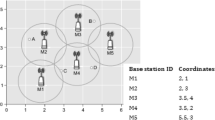Abstract
Dynamic adaptive streaming over HTTP (DASH) is the crucial factor in the rapid penetration of over-the-top (OTT) service providers for on-demand video streaming. It can also be used for live video streaming by the OTT providers. The recent advancements of the HTTP chunked transfer, and the Common Media Application Format (CMAF) echo this tendency, which introduces the possibility to deliver a video segment by small chunks before the full segment is generated. It can deliver live latency of three seconds or less on a conventional DASH player with a small buffer capacity less than the target live latency. However, legacy bitrate adaptation mechanisms inaccurately measure the available bandwidth due to idle times between the chunks at the encoder side. To resolve this problem, we utilize the Software-Defined Networking (SDN) paradigm that directly provides the network statistics with the available bandwidth. We, then, propose an SDN-assisted bitrate adaptation mechanism for live streaming with HTTP 1.1 Chunked Transfer of CMAF packages while keeping the coexistence with the legacy DASH clients. Our SDN-based central framework asynchronously sends the video bitrate levels by continuously monitoring the background traffic flows and the available capacity for DASH clients on the same shared bottleneck link. Results show that our proposed mechanism achieves a lower video freeze rate and provides a better quality-of-experience while reducing the live latency down to about three seconds in the existence of varying background traffic.









Similar content being viewed by others
References
Akamai (2019) Ultra-low-latency streaming using chunked-encoded and chunked- transferred CMAF
Bentaleb A, Begen AC, Zimmermann R, Harous S (2017) Sdnhas: An sdn-enabled architecture to optimize qoe in http adaptive streaming. IEEE Transactions on Multimedia 19(10):2136–2151
Bentaleb A, Timmerer C, Begen AC, Zimmermann R (2019) Bandwidth prediction in low-latency chunked streaming. In: Proceedings of the 29th ACM workshop on network and operating systems support for digital audio and video, NOSSDAV ’19. ACM, New York, pp 7–13
Cisco (2016) White paper: Cisco VNI forecast and methodology. Cisco, San Jose, CA, USA, pp 2015–2020
Claeys M, Latre S, Famaey J, De Turck F (2014) Design and evaluation of a self-learning http adaptive video streaming client. IEEE Commun Lett 18(4):716–719
El Essaili A, Lohmar T, Ibrahim M (2018) Realization and evaluation of an end-to-end low latency live dash system. In: 2018 IEEE international symposium on broadband multimedia systems and broadcasting (BMSB), IEEE, pp 1–5
Forum TDI (2017) Dash ref. player
FTP (2012) Community Floodlight is an open-source sdn controller
Go SJY, Festin CAM, Tan WM (2019) An sdn-based framework for improving the performance of underprovisioned ip video surveillance networks. J Netw Comput Appl 132:49–74
He K, Khalid J, Gember-Jacobson A, Das S, Prakash C, Akella A, Li LE, Thottan M (2015) Measuring control plane latency in sdn-enabled switches. In: Proceedings of the 1st ACM SIGCOMM symposium on software defined networking research, pp 1–6
Jiang J, Hu L, Hao P, Sun R, Hu J, Li H (2018) Q-fdba: Improving qoe fairness for video streaming. Multimed Tools Appl 77(9):10787–10806
Kleinrouweler JW, Cabrero S, Cesar P (2017) An sdn architecture for privacy-friendly network-assisted dash. ACM Trans Multimedia Comput Commun Appl 13(3s):44:1–44:22
Le HT, Ngoc NP, Truong C-T (2018) Bitrate adaptation for seamless on-demand video streaming over mobile networks. Signal Process Image Commun 65:154–164
Lindholm J (2019) The netflix-ication of sports broadcasting. The International Sports Law Journal 18(3):99–101
Ozcelik IM, Ersoy C (2019) Chunk duration–aware sdn-assisted dash. ACM Trans Multimedia Comput Commun Appl 15(3):82:1–82:22
Ozcelik IM, Ersoy C (2020) Low-latency live streaming over http in bandwidth-limited networks. IEEE Commun Lett, pp 1–1
Petrangeli S, Hooft JVD, Wauters T, Turck FD (2018) Quality of experience-centric management of adaptive video streaming services: Status and challenges. ACM Trans Multimedia Comput Commun Appl 14(2s):31:1–31:29
Qian Y, Liu Y, Kong L, Wu M-Y, Mumtaz S (2018) Refer: Resource critical ow monitoring in software-defined networks. In: 2018 IEEE Global Communications Conference (GLOBECOM), IEEE, pp 1–7
Sobhani A, Yassine A, Shirmohammadi S (2017) A video bitrate adaptation and prediction mechanism for http adaptive streaming. ACM Trans Multimed Comput Commun Appl (TOMM) 13(2):18
Sodagar I (2011) The mpeg-dash standard for multimedia streaming over the internet. IEEE MultiMedia 18(4):62–67
Spiteri K, Sitaraman R, Sparacio D (2019) From theory to practice: Improving bitrate adaptation in the dash reference player. ACM Trans Multimedia Comput Commun Appl 15(2s):67:1–67:29
Spiteri K, Urgaonkar R, Sitaraman RK (2016) Bola: Near-optimal bitrate adaptation for online videos. In: IEEE INFOCOM 2016 - The 35th annual IEEE international conference on computer communications, pp 1–9
Team M (2012) Mininet: An instant virtual network on your laptop (or other pc). http://www.mininet.org
Tirumala A (2017) iperf: The tcp/udp bandwidth measurement tool
Van Der Hooft J, Petrangeli S, Wauters T, Huysegems R, Bostoen T, De Turck F (2018) An http/2 push-based approach for low-latency live streaming with super-short segments. J Netw Syst Manag 26(1):51–78
Wang C, Guan J, Feng T, Zhang N, Cao T (2019) Bitlat: Bitrate-adaptivity and latency-awareness algorithm for live video streaming. In: Proceedings of the 27th ACM international conference on multimedia, MM ’19. Association for Computing Machinery, New York, pp 2642–2646
Wei B, Song H, Wang S, Kanai K, Katto J (2019) Evaluation of throughput prediction for adaptive bitrate control using trace-based emulation. IEEE Access 7:51346–51356
Yahia MB, Louedec YL, Simon G, Nuaymi L, Corbillon X Http/2-based frame discarding for low-latency adaptive video streaming, ACM Trans Multimedia Comput Commun Appl 15 (1)
Yi G, Yang D, Bentaleb A, Li W, Li Y, Zheng K, Liu J, Ooi WT, Cui Y (2019) The acm multimedia 2019 live video streaming grand challenge. In: Proceedings of the 27th ACM international conference on multimedia, MM ’19. Association for Computing Machinery, New York, pp 2622–2626
Author information
Authors and Affiliations
Corresponding author
Additional information
Publisher’s note
Springer Nature remains neutral with regard to jurisdictional claims in published maps and institutional affiliations.
Rights and permissions
About this article
Cite this article
Ozcelik, I.M., Ersoy, C. An SDN-aided low-latency live video streaming over HTTP. Multimed Tools Appl 81, 23145–23162 (2022). https://doi.org/10.1007/s11042-022-12389-y
Received:
Revised:
Accepted:
Published:
Issue Date:
DOI: https://doi.org/10.1007/s11042-022-12389-y




